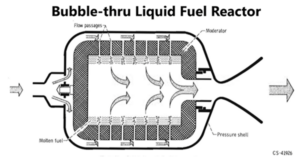Under a nuclear thermal propulsion (NTP) research contract for the Space Nuclear Propulsion project office at NASA’s Marshall Space Flight Center (MSFC), the University of Alabama in Huntsville (UAH) is leading a collaboration of universities across the nation to research the concept of a cutting-edge NTP rocket engine. The NTP will use what’s called centrifugal liquid fuel bubble-through, and if successful, some say it is NASA’s ticket directly into deep space.
All of NASA’s NTP academic partners including the University of Rhode Island (URI), Drexel University, the Massachusetts Institute of Technology (MIT), Pennsylvania State University and the University of Michigan (U-M) gathered on March 11 for a UAH-hosted workshop where NASA discussed progress and issues.
NASA has made substantial advances toward a solid fuel NTP design. The bubble-through concept is under study by the university collaborators and is one of three proposed hydrogen-based designs for a next generation liquid fuel NTP rocket.

Bubble-through heats hydrogen gas propellant to super-hot temperatures, but rather than combusting, the hydrogen literally bubbles through a rotating liquid uranium core in the engine, which is surrounded by a porous cylinder wall, causing the gas to expand rapidly. As it exits the nozzle, the expanding hydrogen provides thrust for the spacecraft.
Dr. Dale Thomas, the project’s principal investigator and an eminent scholar in systems engineering at UAH said the design’s advantages include significantly higher performance over conventional liquid fuel rocket engines.
“In conventional liquid fuel engine combustion, the resulting propellant molecules – H2O in the case of hydrogen and oxygen – are much heavier due to those relatively heavy oxygen atoms, and they will not exit the nozzle as fast, providing more thrust but less impulse,” Dr. Thomas said.
Thrust is the force supplied by the engine i.e. to lift a spacecraft away from Earth’s gravity.
Impulse is the change in momentum per unit of fuel, and that matters in getting a spacecraft where it’s going in space.
Conceptually intriguing, the bubble-through engine presents a number of technical challenges, not the least of which is developing a material for its porous cylinder wall that can withstand direct contact with molten uranium fuel.
“This bubble-through concept has been around since the 1960s,” Dr. Thomas said. “The physics are well understood, but the engineering challenges have precluded getting this concept off the drawing board in the past. We’re in the beginning stages of this. We’re attempting to see whether today’s technologies will let us develop a viable liquid fuel NTP engine prototype.”

A simplified diagram showing the bubble-through nuclear thermal propulsion engine concept.
(Photo courtesy Propulsion Research Center Contributed)
The UAH work focuses in three areas: the first is liquid uranium and gaseous hydrogen thermodynamic heat transfer modeling and analysis.
The second is modeling and analysis of geometry and trajectory of gaseous hydrogen bubbles in a liquid uranium medium; and third, performing experimentation to confirm the analytical predictions of dynamic and thermodynamic models.
Three other UAH professors are also working on the project. Dr. Keith Hollingsworth, professor and department chair of mechanical and aerospace engineering oversees thermodynamics; Dr. Robert Frederick, professor of mechanical and aerospace engineering and director of the Propulsion Research Center is overseeing experimentation; and Dr. Jason Cassibry, associate professor of mechanical and aerospace engineering oversees bubble dynamics.
At MSFC, the researchers are working with Dr. Michael Houts, nuclear research manager.
With liquid fuel NTP, the team has calculated a spacecraft could get to the Kuiper Belt, which starts 4,400,000,000 km from the sun, on a direct trajectory.
What a ride that would be!
Don’t miss out! Subscribe to our email newsletter to have all our smart stories delivered to your inbox.



